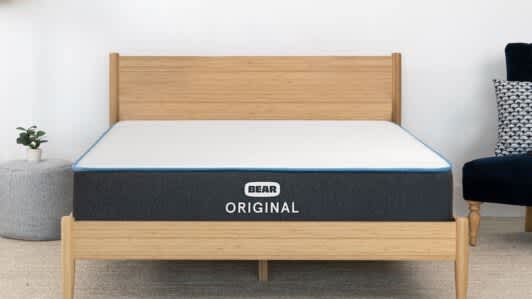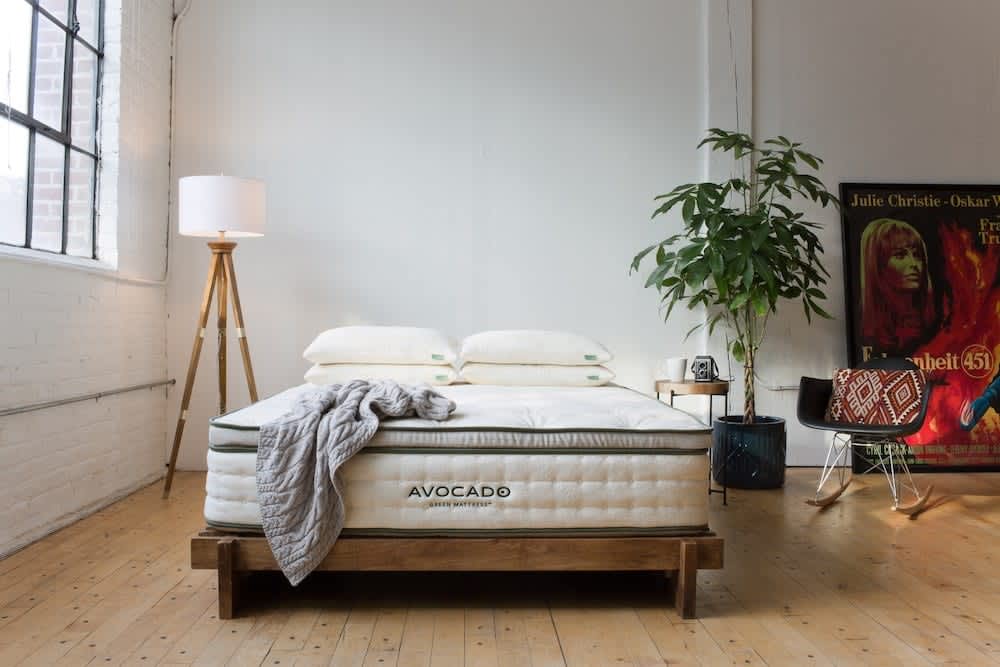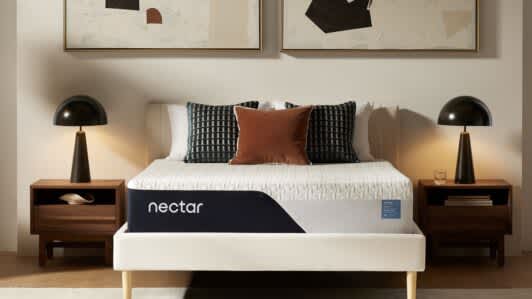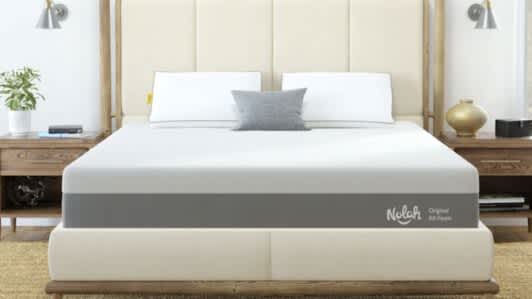On This Page
The Best Twin Mattress of 2025
Our Top Picks
-
Best Overall Mattress
Layla Memory Foam Mattress -
Best Value Mattress
Bear Original -
Most Comfortable Mattress
Helix Midnight -
Best Luxury Mattress
Avocado Green Mattress -
Best Mattress for Side Sleepers
Nectar Mattress -
Best Mattress for Kids
Nolah Original 10
Best Overall Mattress

The Layla Memory Foam Mattress has a flippable design with two distinct feels: medium soft (4) and firm (7). This versatility made it a popular model with many of our testers across sleeping positions and body types.
Pros & Cons
Pros
- Flippable design lets you switch between two firmness options
- Multiple foam layers offer great pressure relief
- Removable cover allows for easy cleaning
Cons
- Soft edges make it difficult to sit on the side of the bed
- Combination sleepers may find it hard to change positions
Ratings
Our Take
Best Value Mattress

When it comes to long-term value, the Bear Original offers great bang for your buck. A firm feel makes the mattress more resistant to wear and tear than most competing all-foam models, but the top layer still provides plenty of padding to reduce pressure and soreness. A reasonable price-point and additional perks for shoppers sweeten the deal even further.
Pros & Cons
Pros
- Firm design is more supportive than the average all-foam model
- Standard and upgrade covers both excel at cooling and moisture control
- Approachable sticker price, free shipping within the contiguous U.S., and generous 120-night trial
Cons
- Strong off-gassing odor may be present for up to 72 hours after unboxing
- Side sleepers under 130 pounds may not receive enough cushioning
Ratings
Our Take
Most Comfortable Mattress

The Helix Midnight may have initially been designed for mid-weight side sleepers, but our testing team agrees this mattress can accommodate a wide range of body types and sleep positions. Consistent cooling, a sturdy perimeter, and excellent pressure relief round out this versatile hybrid.
Pros & Cons
Pros
- Foam-over-coil design offers a nice balance of cushioning and support
- Reinforced perimeter coils protect the edges when you get in and out of bed
- Below-average pricing for a hybrid
Cons
- Initial off-gassing odor may linger for the first few nights
- Back and stomach sleepers over 230 pounds may need a more supportive surface
Ratings
Our Take
Best Luxury Mattress

Eco-conscious shoppers willing to spend a bit more on a twin mattress made with certified organic materials should look no further than the Avocado Green Mattress. The mattress uses GOTS-certified wool and cotton, as well as GOLS-certified latex. The result is a temperature-controlling mattress with great responsive support.
Pros & Cons
Pros
- Environmentally conscious materials
- Optional pillow-top for added plushness
- Exceptional breathability and temperature control
Cons
- Side sleepers under 130 pounds may like a softer mattress
- $99 fee for all returns
Ratings
Our Take
Best Mattress for Side Sleepers

All-foam mattresses are typically great at relieving undue pressure on a side sleeper’s shoulders and hips, and the Nectar Mattress is no exception. Thanks to a firmer-than-average feel, the mattress had well-rounded performance during our tests. You also can’t beat the competitive price-point, year-long sleep trial, and lifetime warranty.
Pros & Cons
Pros
- Performs well for side sleepers of any body weight
- Memory foam layers conform to heavier parts of the body
- Cooling gel in comfort layer designed to reduce heat retention
Cons
- Edges not quite firm enough to sleep near the edge
- Memory foam can make it more awkward to change sleeping position
Ratings
Our Take
Best Mattress for Kids

The Nolah Original 10 is a plush all-foam mattress that’s suitable for adults and children alike. Cushioning foam layers that cradle the body without trapping heat, and the sticker price should definitely appeal to parents with limited budgets.
Pros & Cons
Pros
- Plush all-foam design offers deep contouring and cushioning
- Open-cell layers are designed to resist heat buildup
- Tencel cover intended to promote cooling and wick away moisture
Cons
- Strong off-gassing odor may persist for several nights after unboxing
- Most back and stomach sleepers won’t receive adequate support
Our Take
Compare Our Top Picks
| Mattress | Mattress Type | Ideal For | Value | Sleep Trial |
| Layla Memory Foam Mattress | Foam | People With Sharp Pressure Points | Great Value | 120 nights |
| Bear Original | Foam | Side and Back Sleepers | Great Value | 120 nights (30-night break-in period) |
| Helix Midnight | Hybrid | Combination Sleepers | Good Value | 100 nights (30-night requirement) |
| Avocado Green Mattress | Latex Hybrid | Couples | Good Value | 365 nights (30-night break-in period) |
| Nectar Mattress | Foam | Side Sleepers | Great Value | 365 nights |
| Nolah Original 10 | Foam | Couples | Good Value | 120 nights (30-night requirement) |
Twin is the smallest of the six standard mattress sizes. Designed for one person, a twin mattress is an affordable option for people who live in dorms, studio apartments, and other places with limited sleeping space. Twin sizes are also ideal for children who sleep in bunk beds or are transitioning to their first big kid’s bed.
Who Should Consider a Twin Size Mattress?
Twin size mattresses, also sometimes called single mattresses, are well suited for anyone who wants to save space and doesn’t need a larger bed. Twins are a great fit for bunk beds and children transitioning from cribs to a larger mattress. This size also provides ample sleeping space for most growing kids and teens. Single adults living in studio apartments or shared living situations may also find the twin size ideal for its space-saving dimensions.
Keep in mind that a twin may be too narrow for couples and too short for sleepers over 6 feet tall. Couples and taller sleepers who want a narrow mattress might find a twin XL or full mattress more accommodating.
Twin vs. Twin XL
Twin and twin XL mattresses are both 38 inches in width, but differ in length. The twin measures 75 inches (6 feet 3 inches), while the twin XL adds an extra 5 inches, making it more suitable for taller individuals, particularly teens and adults over 6 feet in height. Both sizes fit single sleepers and work well in small spaces, but the twin XL offers that bit more legroom.
How to Shop for a Twin Size Mattress
When shopping for a twin mattress, consider many of the same factors as other sizes to ensure the mattress meets your unique needs and preferences.
Mattress Type
After choosing the right size, consider the pros and cons of each mattress type. Many twin mattresses are constructed of foam and excel in contouring and pressure relief. Latex mattresses are more expensive, but offer durability and a responsive feel. Hybrids combine one of these materials with a coil support core, balancing support and comfort. Less common twin mattress types include innerspring models and airbeds.
Firmness
The firmness of a mattress affects your overall sleep experience, with the right level dependent on your sleeping position and body weight. Softer mattresses may benefit side sleepers and sleepers under 130 pounds, while firmer options are better suited for back sleepers and those with a heavier build.
Support
Support in a mattress is all about maintaining neutral spinal alignment and avoiding pressure build-up in key areas of your body. Support is not only a reflection of a mattress’ quality and construction, but also hinges on whether the mattress is tailored to your usual sleeping position and body weight.
Price
How much to expect to pay for a twin mattress ranges from around $200 for a budget option to over $1000 for a luxury mattress with premium features. Mattress price is influenced by factors like mattress type, quality, brand reputation, and added features, so consider your budget and needs carefully.
Discover More Mattress Solutions
More Mattress Size Options
How We Test
When it comes to mattresses, we know our stuff. We research every mattress we review and put each one through extensive testing in our Seattle-based office. Our team includes product testers with a mix of different body weights and sleep styles, to make sure we can confidently say how a mattress will perform for people of different shapes and sizes. We use our years of experience and hands-on testing to give you recommendations you can count on.
Frequently Asked Questions
A twin mattress typically measures 38 inches in width and 75 inches in length. That’s enough room for most kids, teens, and single adults to stretch out comfortably, but it’s still cozy enough for smaller rooms.
You can pick up a twin mattress anywhere from $200 for a budget all-foam model to over $1000 for a premium latex, hybrid, or mattress made with organic materials. Factors like material, quality, brand, and additional features significantly impact the cost.
The weight of a twin mattress depends on its construction and materials, generally ranging from 40 and 70 pounds. The exact weight depends on what’s inside – like foam, latex, or coils. Foam mattresses are usually the lightest, while latex and coils can add significant weight to a bed.
Twin XL mattresses are 5 inches longer than standard twin mattresses. This makes them more suitable for taller sleepers and anyone needing extra legroom. Both sizes are the same width, so they’re still best for one person.
Twin mattresses are a popular choice for teenagers. They offer sufficient space for most teens while fitting well in smaller bedrooms, dorm rooms, or shared spaces. Plus, twins are the most affordable standard mattress size, making them a budget-friendly option for teens.
